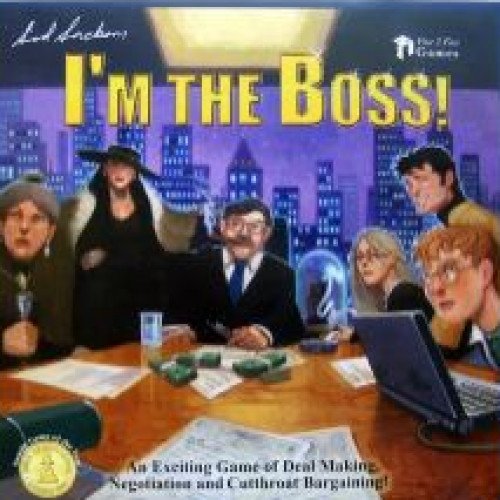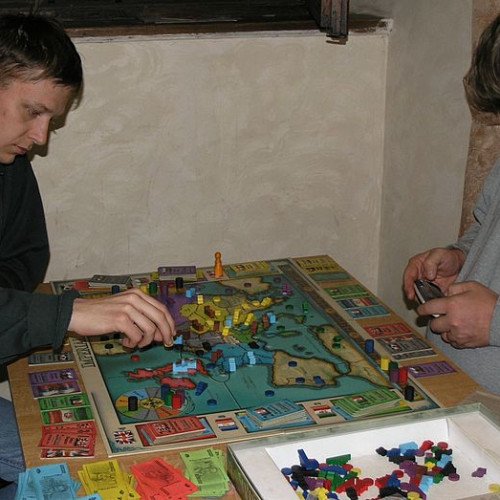"I'M THE BOSS!" vs "IMPERIAL"

I'M THE BOSS!
I'm the Boss! is a board game by American designer Sid Sackson. It is a negotiation game in which a group of players compete and cooperate to put together profitable business deals. The goal is to make the most money. I'm the Boss is currently published by Gryphon Games, after the Face2Face Games edition. It was previously published as Kohle, Kies & Knete. The money is sorted into denominations. Each player is randomly issued investor cards (usually one), with remainders placed face up near the board. The player with the first investor alphabetically will play first; the player to his right chooses which board space to place the dollar marker upon. The deck is shuffled and each player is dealt five cards. The tiles are sorted in order and placed on the board. Players act in turn. On each game turn, the acting player may either leave the marker in place or roll the die and advance the marker. If he does the latter, he may either play the new space or draw three cards from the deck. If a player does not draw cards, he may attempt to make a deal based on the current board position. Notations on the board dictate which investors must be involved to close the deal, as well as the number of shares that will pay out. The tile indicates the share price. Most spaces offer choices as to which investors to involve, while some do not. In order for a deal to occur, players who control the required investors must agree to the terms proposed by the acting player. Terms may only specify which investors will be involved and how the total proceeds of the deal will be distributed: no other offer of consideration is legal play. Players need not control an investor involved in the deal in order to be included in its terms. In particular, the acting player may propose a deal where he draws proceeds merely for the service of allowing the deal to go through. If an agreement is reached, the proceeds (share price × number of shares) are distributed as agreed. The current tile is placed over the current board space, indicating that the deal was done. Such spaces are skipped in future board movement. If the acting player cannot bring negotiations to a satisfactory conclusion, he may end his turn. No proceeds are generated and the current tile and board space remain as before.
Statistics for this Xoptio

IMPERIAL
Imperial is a German-style board game designed by Mac Gerdts in which the object is to accumulate wealth in the form of bond holdings in successful countries and cash. Players take on the role of international financiers who purchase government bonds in the six pre-World War I empires of Austria-Hungary, France, Germany, Great Britain, Italy, and Russia. The principal bondholder of a nation gains control of its government and can order importation or production of armaments and ships; maneuvering of military units; construction of factories; and taxation. During play, an investor card is passed around which allows the purchase of additional bonds. A rondel – a wheel-shaped game mechanism with eight different options – is used to determine the options available to a country. The game box states that it is for 2–6 players, but a developer-supported variant allows play with seven. Imperial 2030 is a follow-up game released in 2009 with similar mechanics. The players of Imperial are wealthy banking families who surreptitiously control and exploit European governments from behind the scenes. Control of the majority of a country's debt allows the player to control the country's actions. A key element of the game is separating the player's money from each country's treasury. Country's treasuries gain money from taxation, which increases based on how much territory the country controls, and from players buying bonds from that country. Players gain money by earning success bonuses from countries they control, earning 2,000,000 when the investor card they hold is activated, and most importantly from dividends of bonds they've previously purchased. Thus, gaining player money can be a two-step process – one must first buy a country's bonds, then get that money out of the country and into their own pocket by forcing the country to constantly pay interest/dividends on the loaned money. A country only spends money on two other things – importing military units (1M apiece) and building factories (5M apiece), so most money put into a treasury becomes available to pay back to investors. Money left in a country's treasury at the end of the game does not count toward helping any player win. In the taxation phase, a country's treasury receives 2M for each unoccupied factory, plus 1M for each tax chip, minus 1M for each military unit. The country's octagonal game piece is moved to the appropriate number on the power chart, and if the country has moved up on the tax chart, a success bonus is paid to the player who holds that country's flag. When a country reaches 25 points on the counting chart, the game ends. Players' bond holdings in each country are public knowledge; current cash on hand is allowed to be kept secret.